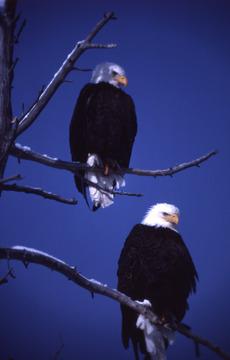Bald eagles are continuing to find Voyageurs National Park to their liking, with 69 nests sighted this spring. Thirty-eight of those nests had adults focused on incubating eggs, according to park officials.
Park biologists conducted their 37th annual spring aerial survey for bald eagles back on April 16. The 38 nests they spotted with adults in them continued an upward trend that has been noted in the past decade. During the 2008 survey, 29 nests with adults in them were spotted, while in 2007 the number was 24. Back in 1999 just 20 nesting eagles were seen during the survey.
Two nests observed late last summer were absent this year either due to blow down or nest collapse. Thirty-one nests were not actively being used by adults for incubating eggs; however, two new nests were discovered on Rainy and Kabetogama Lakes.
Each year since 1992, the park has temporarily closed the land and water areas around active bald eagle nests to visitor use during their critical nesting periods. These closures follow the conservation management actions of the Bald Eagle and Golden Eagle Management Act. Specific management recommendations from a two-year research study on the effects of watercraft on bald eagles nesting in Voyageurs will be applied for the fifth consecutive year.
Thirteen of the park’s 38 active nesting sites occupied by breeding pairs are temporarily closed to campers and other human activities effective immediately. After the young leave the nest, which usually occurs by the middle of August, these temporarily closures will be lifted. Motorized and non-motorized watercraft users are to avoid land or water approaches to the bald eagle nesting sites within 200 meters during the closure period. Boaters are encouraged to not stop on the water when passing near these locations. All closed areas will are marked with signs or buoys.
Five of the park’s 239 designated camping, houseboat and day use sites are affected by the temporary closures. The closed designated sites are: Kabetogama Lake-Yoder Island (K37) and Ek’s Bay (K47) houseboat sites; Namakan Lake –Hamilton Island East (N11) campsite; Rainy Lake-Skipper Rock Island (R45) and Sand Bay South (R25) houseboat sites.
Eight undeveloped areas that frequently receive visitor use near active breeding pairs are also closed to human activity: Kabetogama Lake–North Wood Duck Island Beach, Pine Island South, Richie Island, West Sphunge Island Inlet, West Zollner Island, West Harris Island Point and West Cemetery Island; Rainy Lake- North Diamond Island.
People play a very important role in protecting nesting eagles and other birds. Individual eagles differ in temperament and tolerance to human and natural activities. Some are easily displaced by human/eagle interactions, whereas others are more accustomed to close interactions with humans. May and June are particularly sensitive periods for nesting eagles. Eagles may still be incubating eggs until late May, and if flushed off the nest for too long a period, the eggs will cool causing the embryos to die.
Newly hatched eaglets are unable to regulate their body temperatures and require constant attention from an adult to protect them from cold winds and rain, or hot sunshine. If the adults are continuously threatened, they may abandon their protective nesting efforts. After eaglets are able to regulate their own body temperatures they are not as vulnerable when the parent is absent.
“There has been a steady increase in eagle nesting activity within Voyageurs National Park during the past 37 breeding seasons. This trend and the annual increase in the number of young fledged within the park is good news for a healthy eagle population," says Voyageurs Superintendent Mike Ward. "Overall, we believe that by reducing the adverse potential of human/eagle interactions around our active bald eagle nesting sites we have allowed for greater nesting success. At the same time we have increased the potential to view more eagle activity for our visitors. Our specific management goal is to help ensure the continued reproductive success and sustainability of the park’s bald eagle population and that strategy appears to be working well.”




Add comment